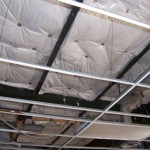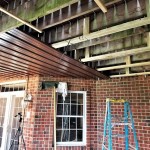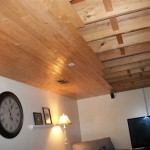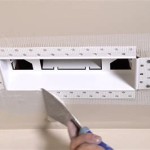What Size Ceiling Fan for Vaulted Ceilings: A Comprehensive Guide
Selecting the appropriate size ceiling fan for a room with a vaulted ceiling requires careful consideration of several factors. Unlike rooms with standard, flat ceilings, vaulted spaces present unique challenges due to their angled architecture and increased volume. A fan that is too small will be ineffective in circulating air, while one that is too large can overwhelm the space and potentially pose safety concerns. This article provides a detailed guide to determining the optimal ceiling fan size for vaulted ceilings, ensuring efficient airflow and comfortable living spaces.
Understanding the Basics of Ceiling Fan Sizing
The primary factor in determining the correct ceiling fan size is the room's square footage. Manufacturers typically provide guidelines correlating blade span (the diameter of the circle the blades create) with room size. These recommendations are generally based on standard ceiling heights (around 8 feet). However, vaulted ceilings introduce an additional element: the overall volume of the space. Greater volume requires moving more air to achieve the desired cooling or heating effect.
For standard ceiling heights, the following guidelines are generally applicable:
- Rooms up to 75 square feet: 36-inch fan
- Rooms between 76 and 144 square feet: 42-inch fan
- Rooms between 144 and 225 square feet: 52-inch fan
- Rooms larger than 225 square feet: 56-inch or larger fan, or multiple fans
These figures serve as a starting point. When dealing with vaulted ceilings, adjustments are necessary to compensate for the increased air volume.
Key Point 1: Adapting Size Recommendations for Vaulted Ceiling Height
When assessing a vaulted ceiling, it’s critical to consider the average ceiling height rather than just the lowest point. While the lower edges of a vaulted ceiling might be at a standard 8-foot height, the apex of the vault significantly increases the overall height and, consequently, the volume of the room. A general rule is to add a size increment to the recommended fan size if the highest point of the vault exceeds 10 feet. This compensates for the increased volume of air needing circulation.
For example, if a room measures 200 square feet (typically suited for a 52-inch fan) and has a vaulted ceiling peaking at 12 feet, opting for a 56-inch or even a 60-inch fan might be more appropriate. Another important aspect is the slope of the ceiling. A steeper slope equates to a greater air volume above the standard ceiling height, necessitating a larger fan.
Beyond simply upsizing the fan, consider the CFM (cubic feet per minute) rating of the fan. The CFM rating indicates the volume of air the fan moves at its highest speed. For vaulted ceilings, prioritize fans with higher CFM ratings. Although blade span and CFM are related, blade pitch (the angle of the blades) also significantly impacts CFM. A steeper blade pitch will typically move more air. When comparing fans of the same size, always consider the CFM rating as a crucial performance indicator.
It is also important to consider the layout of the room. An open-concept space with a vaulted ceiling flowing into other living areas will require a fan with a larger CFM rating to effectively circulate air throughout the entire combined space. Conversely, a smaller, more enclosed room with a vaulted ceiling will benefit from a fan that's adequately sized but doesn't create excessive drafts.
Calculating Extended Downrod Length
The distance between the fan blades and the floor is another critical consideration, particularly with vaulted ceilings. For optimal safety and performance, the fan blades should be at least seven feet above the floor. Since vaulted ceilings often have lower points that are closer to the floor than standard ceilings, an extended downrod is frequently required. The downrod is the metal pipe connecting the fan motor to the mounting bracket. It allows the fan to hang lower, ensuring adequate clearance from the ceiling while maintaining the recommended blade-to-floor distance.
To calculate the necessary downrod length, measure the distance from the ceiling's lowest point to the floor. Subtract seven feet (the desired blade-to-floor clearance) from this measurement. The resulting number is the minimum length of downrod required. For example, if the lowest point of the vaulted ceiling is 9 feet from the floor, then a downrod of at least 2 feet (24 inches) is required. It's always prudent to err on the side of slightly longer downrod rather than shorter, as adjustments can be made, but safety should always be the paramount concern.
When selecting a downrod, ensure it is compatible with the chosen ceiling fan model. Different fan manufacturers use different downrod connection systems. Using an incompatible downrod can compromise the fan's stability and potentially lead to mechanical failure. Also, consider the aesthetic impact of the downrod. Longer downrods may require a finish that complements the fan and the room's overall décor.
The length of the downrod can also affect the fan's efficiency. The goal is to position the fan so the blades are circulating air within the occupied space, not just near the ceiling. Too long a downrod might place the blades too low, increasing the risk of drafts and reducing the fan's effectiveness in circulating air throughout the upper portion of the room. This is especially important in summer, where the goal is to circulate cooler air near the floor.
Key Point 2: Mounting Options and Ceiling Slope Adaptability
Vaulted ceilings necessitate specific mounting hardware and techniques to ensure the fan is securely attached and operates safely. Standard ceiling fan mounting brackets are designed for flat ceilings. To accommodate the slope of a vaulted ceiling, a specialized “angled ceiling adapter” or “sloped ceiling kit” is required. These adapters allow the fan to hang plumb (vertically straight) even when mounted on an angled surface. They typically consist of a ball-and-socket joint that allows the fan to swivel and maintain its vertical orientation.
Before purchasing a ceiling fan and associated mounting hardware, carefully measure the ceiling's slope. The slope is typically expressed as a ratio (e.g., 4/12, meaning the ceiling rises 4 inches for every 12 inches of horizontal distance). Most angled ceiling adapters are designed to accommodate a specific range of slopes. Exceeding the adapter's maximum slope rating can compromise the fan's stability and potentially lead to damage or injury.
Installation of ceiling fans on vaulted ceilings often involves working at heights. For safety, it is highly recommended to hire a qualified electrician or experienced handyman who is familiar with the specific challenges and best practices for installing ceiling fans on angled surfaces. Proper wiring, secure mounting, and precise balancing are crucial for ensuring the fan operates safely and efficiently.
When dealing with very steep vaulted ceilings, consider the potential need for structural reinforcement. If the ceiling's framing is not sufficiently robust to support the weight of the fan (especially larger, heavier models), additional bracing or support beams may be required. A structural engineer can assess the ceiling's load-bearing capacity and recommend appropriate reinforcement measures.
Choosing the Right Fan Type and Features
While size and mounting are critical, selecting the right type of ceiling fan with appropriate features is also essential for optimizing comfort and energy efficiency in a vaulted space. Consider features such as remote control operation, reversible motor direction, and energy-efficient DC motors.
A remote control is particularly useful for controlling ceiling fans installed in vaulted ceilings, as adjusting the fan speed or direction manually might be difficult. Reversible motor direction allows the fan to be used effectively in both summer and winter. In summer, the fan should rotate counter-clockwise to create a cooling breeze. In winter, it should rotate clockwise at a low speed to gently circulate warm air trapped near the ceiling back down into the occupied space, improving heating efficiency.
Modern ceiling fans increasingly utilize DC (direct current) motors, which are significantly more energy-efficient than traditional AC (alternating current) motors. DC motors typically consume up to 70% less energy while providing comparable airflow. Although DC fans may have a higher initial cost, the energy savings over their lifespan can offset the price difference.
Also consider the design and aesthetic of the ceiling fan. A vaulted ceiling often draws the eye upward, making the fan a focal point of the room. Choose a fan style that complements the room's décor and architectural features. Consider the fan's finish, blade material, and overall shape to create a cohesive and visually appealing space.
Key Point 3: Optimizing Air Circulation Strategies
Beyond simply selecting the right size fan, optimizing air circulation in a vaulted space requires considering the placement of the fan in relation to the room's layout and other HVAC systems. The goal is to create a consistent and comfortable air temperature throughout the entire space, minimizing temperature stratification (where warm air rises and cooler air settles).
Experiment with different fan speeds and directions to find the optimal settings for different seasons and occupancy levels. In summer, using a higher fan speed can create a stronger cooling breeze. In winter, using a lower speed and reversing the fan direction can gently destratify the air without creating noticeable drafts.
Consider using multiple ceiling fans in larger vaulted spaces to improve air circulation. Strategically placing multiple fans can create a more consistent airflow pattern and eliminate dead zones where air is stagnant. Multiple smaller fans can often be more effective than a single oversized fan, especially in irregularly shaped rooms.
Integrate the ceiling fan with other HVAC systems, such as air conditioners and heaters, to improve overall energy efficiency. Using a ceiling fan in conjunction with an air conditioner can allow you to set the thermostat a few degrees higher without sacrificing comfort, reducing energy consumption. Similarly, using a ceiling fan in winter to circulate warm air can reduce the strain on the heating system.
Pay attention to the placement of furniture and other obstructions that might impede airflow. Avoid placing tall furniture directly beneath the ceiling fan, as this can disrupt the fan's airflow pattern and reduce its effectiveness. Ensure that the fan blades have sufficient clearance from walls and other objects to operate safely and efficiently.
Regularly clean the fan blades to maintain optimal performance. Dust buildup on the blades can reduce their efficiency and potentially lead to imbalance and vibration. Use a soft cloth or duster to clean the blades periodically, especially if the fan is located in a dusty environment.
By carefully considering these factors, one can effectively select and install the correct size ceiling fan for a vaulted ceiling, ensuring improved comfort, energy efficiency, and overall living space appeal.

Ceiling Fan Size Guide Delmarfans Com

Ceiling Fan Size Guide Delmarfans Com

Ceiling Fan Guide The Home Depot

How To Choose A Ceiling Fan For Vaulted Ceilings Lightology

Ceiling Fan Size Guide Delmarfans Com

Ceiling Fan Size Guide Delmarfans Com

Ceiling Fan Size Guide Delmarfans Com

Ceiling Fan Guide The Home Depot

How To Choose A Ceiling Fan For Vaulted Ceilings Lightology

Ceiling Fan Guide The Home Depot
Related Posts








